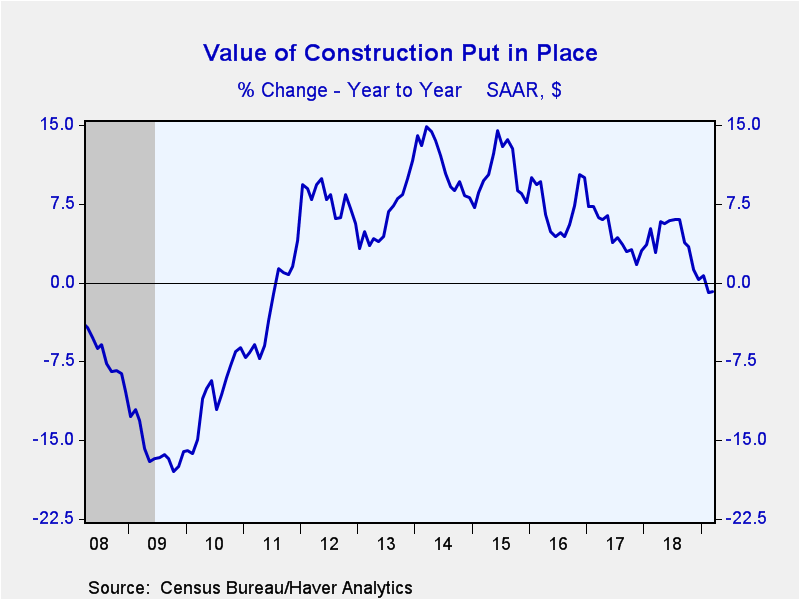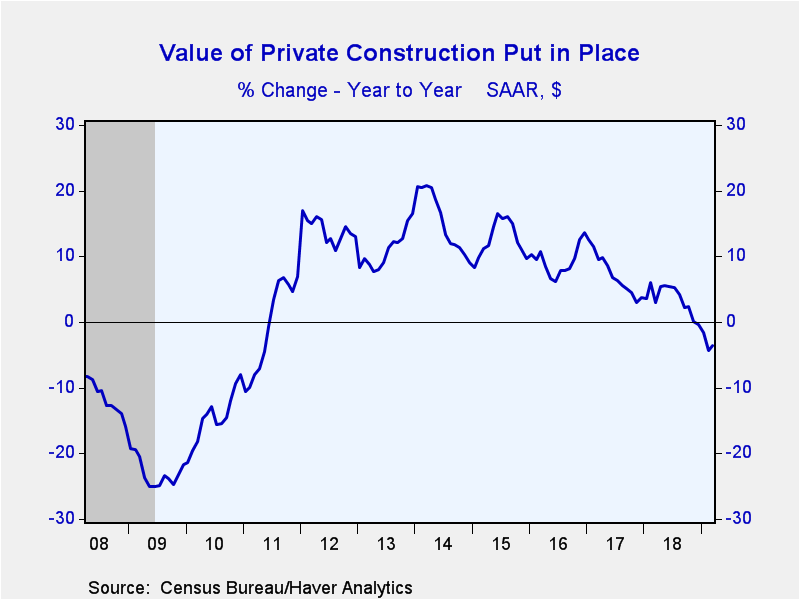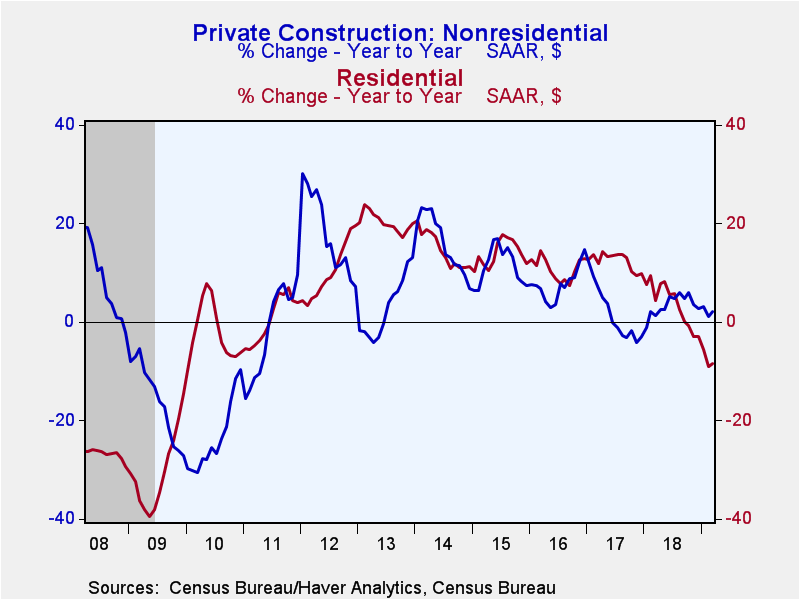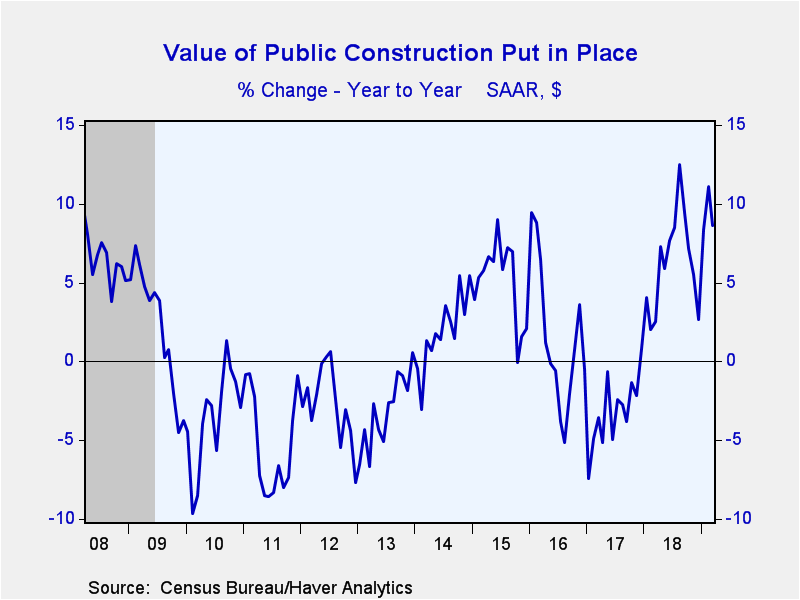 Global| May 01 2019
Global| May 01 2019U.S. Construction Spending Fell in March
by:Sandy Batten
|in:Economy in Brief
Summary
The value of construction put-in-place decreased 0.9% m/m (-0.8% y/y) in March following a 0.7% m/m increase (revised down from +1.0%) in February. The Action Economics Forecast Survey had expected a 0.1% m/m rise. The y/y decline in [...]
The value of construction put-in-place decreased 0.9% m/m (-0.8% y/y) in March following a 0.7% m/m increase (revised down from +1.0%) in February. The Action Economics Forecast Survey had expected a 0.1% m/m rise. The y/y decline in March followed one in February. These are the first y/y declines since July 2011. For all of the first quarter, total construction spending increased 0.5% q/q, in contrast to declines in both Q3 and Q4 last year. The modest rise in 2019 Q1 was more than accounted for by public construction, which rose 6.0% q/q (its largest quarterly gain since 2015 Q2). Private construction fell 1.1% q/q in Q1, its third consecutive quarterly decline.
Both private and public construction spending declined in March with private spending slipping 0.7% m/m (-3.6% y/y) and public spending falling a more pronounced 1.3% m/m (+8.6% y/y).
The fall in private spending was concentrated in weaker residential construction (-1.8% m/m, -8.4% y/y), particularly construction of single-family homes (-1.5% m/m). The value of residential improvements fell sharply, posting a 3.1% m/m decline (-14.1% y/y) in March. Private nonresidential construction edged up 0.5% m/m in March (+2.1% y/y) with monthly gains widely spread across sectors, led by a 2.5% m/m (10.9% y/y) increase in manufacturing construction.
The weakness in public construction was led by the two major categories that account for more than 55% of total public construction spending—educational construction and construction of highways and streets. Education construction fell 1.5% m/m (+5.8% y/y) in March for its first decline in three months. Construction of highways and streets plummeted 1.9% m/m (+13.2% y/y) in March but this was after having jumped up 11.4% m/m in January and 8.9% m/m in February. For all of the first quarter, construction of highways and streets soared 15.1% q/q.
The construction spending figures, some of which date back to 1946, are in Haver's USECON database. The expectations reading can be found in the AS1REPNA database.
| Construction Put in Place (SA, %) | Mar | Feb | Jan | Mar Y/Y | 2018 | 2017 | 2016 |
|---|---|---|---|---|---|---|---|
| Total | -0.9 | 0.7 | 0.7 | -0.8 | 3.8 | 4.5 | 7.0 |
| Private | -0.7 | -0.2 | -0.9 | -3.6 | 3.1 | 7.1 | 9.2 |
| Residential | -1.8 | -0.4 | -2.9 | -8.4 | 2.8 | 12.4 | 10.7 |
| Nonresidential | 0.5 | 0.1 | 1.5 | 2.1 | 3.4 | 1.3 | 7.7 |
| Public | -1.3 | 3.2 | 5.8 | 8.6 | 6.4 | -3.2 | 0.7 |
Sandy Batten
AuthorMore in Author Profile »Sandy Batten has more than 30 years of experience analyzing industrial economies and financial markets and a wide range of experience across the financial services sector, government, and academia. Before joining Haver Analytics, Sandy was a Vice President and Senior Economist at Citibank; Senior Credit Market Analyst at CDC Investment Management, Managing Director at Bear Stearns, and Executive Director at JPMorgan. In 2008, Sandy was named the most accurate US forecaster by the National Association for Business Economics. He is a member of the New York Forecasters Club, NABE, and the American Economic Association. Prior to his time in the financial services sector, Sandy was a Research Officer at the Federal Reserve Bank of St. Louis, Senior Staff Economist on the President’s Council of Economic Advisors, Deputy Assistant Secretary for Economic Policy at the US Treasury, and Economist at the International Monetary Fund. Sandy has taught economics at St. Louis University, Denison University, and Muskingun College. He has published numerous peer-reviewed articles in a wide range of academic publications. He has a B.A. in economics from the University of Richmond and a M.A. and Ph.D. in economics from The Ohio State University.










